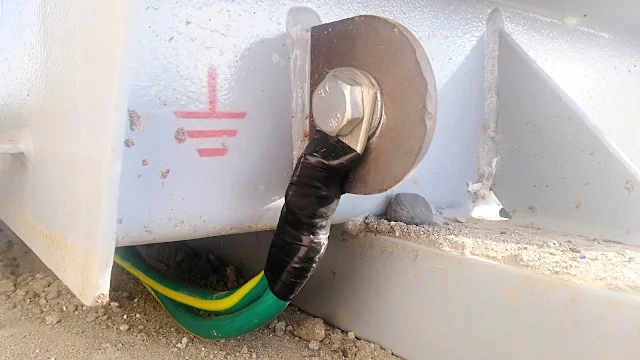What Is Electrical Grounding?
Electrical grounding refers to the process of connecting an electrical system to the earth through a conductor. The primary purpose is to provide a low-resistance path for fault currents to safely dissipate into the ground. This protects both equipment and individuals from potential hazards.
Types of Grounding
System Grounding: This involves connecting a part of the electrical system, such as the neutral point of a transformer, to the ground. System grounding ensures voltage stability and aids in fault current detection.
Example: In a three-phase power system, the neutral point of a wye-connected transformer is grounded to ensure proper fault detection and voltage balance.
Equipment Grounding: This ensures that all non-current-carrying metallic parts of electrical equipment are connected to the ground. If a fault occurs, such as a live wire coming into contact with a metal enclosure, the current is directed safely to the ground instead of posing a risk to people.
Example: Metal frames of household appliances like washing machines and refrigerators are grounded to prevent electric shocks.
Techniques for Effective Grounding
Direct Burial: Ground rods, plates, or grids are buried directly in the soil to establish a connection with the earth.
Concrete-Encased Electrodes (Ufer Ground): This technique involves embedding grounding conductors, such as rebar, in concrete foundations, enhancing the connection to the earth.
Grounding Mesh: A network of conductors is installed underground to improve the dissipation of fault currents, especially in industrial settings.
What Is Electrical Bonding?
Methods of Bonding
Mechanical Connections: Using bolts, clamps, or other hardware to join metallic parts.
Welding: Permanently bonding metals using thermal techniques for reliable conductivity.
Exothermic Welding (Cadweld): A chemical process that creates a molecular bond between conductors for superior durability.
Key Differences Between Grounding and Bonding
While often used together, grounding and bonding serve different purposes:
Grounding: Focuses on establishing a direct connection to the earth.
Bonding: Ensures all conductive components are electrically connected to prevent potential differences.
Importance of Grounding and Bonding
Safety: Proper grounding and bonding prevent electric shocks by providing a path for fault currents to flow to the ground, reducing the risk of injury.
Equipment Protection: By ensuring a stable voltage and providing a path for surges and fault currents, grounding and bonding help protect electrical equipment from damage.
Fire Prevention: Grounding reduces the likelihood of electrical fires caused by stray currents or arcs.
Compliance: Electrical codes, such as the National Electrical Code (NEC), mandate proper grounding and bonding to ensure safety and standardization.
Components of Grounding and Bonding Systems
1. Grounding Electrode System
The grounding electrode system is the physical connection to the earth. Common grounding electrodes include:
Ground rods: Copper or galvanized steel rods driven into the earth.
Metal water pipes: Used as grounding electrodes if they meet code requirements.
Concrete-encased electrodes (Ufer grounds): Rebars embedded in concrete foundations.
Ground plates: Metal plates buried in the soil.
2. Grounding Conductors
Grounding conductors connect the system to the grounding electrode. They must be of sufficient size and material (typically copper or aluminum) to handle potential fault currents.
3. Bonding Conductors
Bonding conductors ensure all metallic parts of a system are electrically connected. These conductors bridge enclosures, equipment frames, and other metallic components.
4. Main Bonding Jumper
The main bonding jumper connects the grounded conductor (neutral) to the equipment grounding conductor and the grounding electrode system within the main service panel.
Steps for Proper Grounding and Bonding
Design Phase: Include grounding and bonding in the electrical system’s design to meet code requirements and system specifications.
Material Selection: Use approved materials, such as corrosion-resistant conductors and connectors.
Installation: Follow standards such as the NEC or IEC to ensure all connections are secure and conductive paths are established.
Testing: Use tools like ground resistance testers and bonding continuity testers to verify system integrity.
Maintenance: Periodically inspect grounding and bonding systems for corrosion, loose connections, or wear.
Common Mistakes to Avoid
Improper Grounding Electrode Installation: Ground rods must be driven to the required depth and resistance to be effective.
Neglecting Bonding: Failing to bond metallic parts can result in voltage differences and potential hazards.
Using Undersized Conductors: Fault currents require conductors of adequate size to safely dissipate energy.
Ignoring Local Codes: Compliance with local electrical codes is essential for safety and legality.
Real-World Applications
Grounding and bonding are indispensable in various sectors:
Residential: Grounding protects home appliances and individuals from electrical faults.
Example: A home’s electrical panel is connected to a grounding electrode to protect against lightning surges.
Industrial: Bonding ensures operational safety in facilities with extensive metal structures and machinery.
Example: Bonding of pipelines and tanks in chemical plants minimizes static discharge.
Renewable Energy Systems: Proper grounding is crucial for solar and wind power systems to prevent surges and ensure system stability.
Example: Solar panel frames and inverters are grounded to protect against lightning strikes.
FAQs on Grounding and Bonding
1. What happens if a system isn’t properly grounded?
Improper grounding can result in voltage instability, electric shocks, equipment damage, and increased fire hazards.
2. Why is bonding necessary for metal parts?
Bonding ensures all metal parts are at the same electrical potential, preventing voltage differences that could cause shocks.
3. How often should grounding systems be inspected?
Grounding systems should be inspected annually or after any significant electrical event, such as a lightning strike.
4. Can I use the same conductor for grounding and bonding?
While some conductors can serve dual purposes, it’s essential to follow local codes to ensure compliance.
5. What tools are used to test grounding systems?
Common tools include:
Ground Resistance Testers: Measure the resistance of grounding electrodes.
Clamp Meters: Test bonding continuity without disconnecting conductors.
Conclusion
Electrical grounding and bonding are foundational practices in electrical engineering. They ensure safety, protect equipment, and maintain system functionality. By adhering to best practices, understanding the principles, and complying with standards, engineers and electricians can create systems that are both safe and efficient. Examples, proper techniques, and routine maintenance ensure that these systems remain effective, providing peace of mind and operational reliability.

